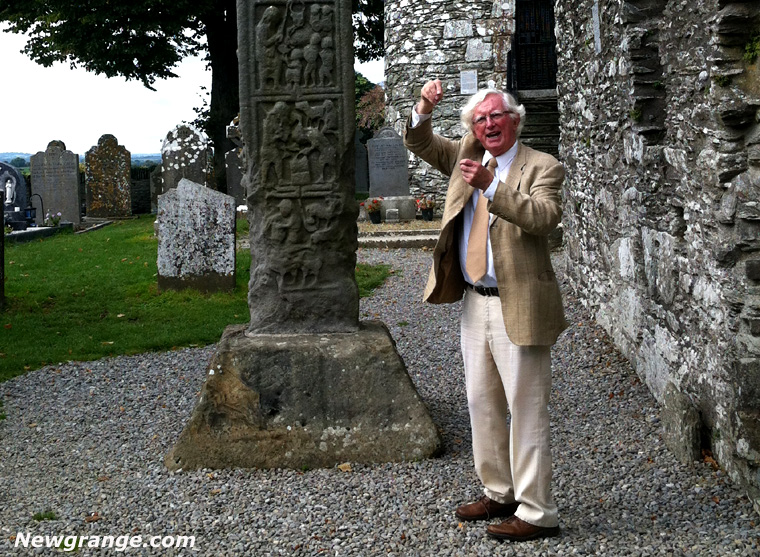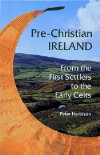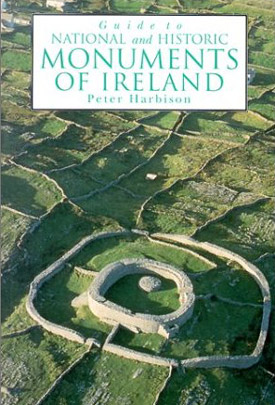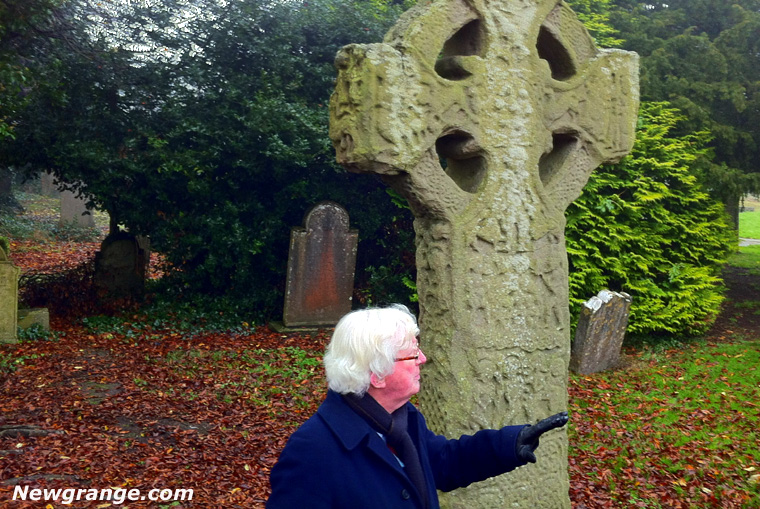Peter Harbison (1939-2023)

Peter Harbison delivering his usual dramatic style lecture at the West High Cross, Monasterboice
Obituary printed in The Irish Times - 24 June 2023
Dr Peter Desmond Harbison, who has died aged 84, was unique in several senses. Although he never occupied a post in any Irish university school of archaeology, he was one of the best-known archaeologists in this country. Through his work with Bord Fáilte as its archaeologist from 1966, he was an effective communicator, both here and abroad, of the sheer enormity of the riches of Ireland's cultural past, especially of its medieval past. He played an important role in the development of cultural tourism to and within Ireland.Remarkably, Harbison combined what was essentially a marketing role with a prodigious output of both scholarly writings of the first rank and works for a general readership, which totalled at least 38 self-authored titles and 28 co-authored ones, and papers in at least 363 different publications globally.
The most important work of this phenomenal productivity was, very probably, his three-volume study The High Crosses of Ireland (1992), the definitive work on its subject. Other ground-breaking books included Irish Medieval Figure Sculpture 1200-1600 (1974, with co-author John Hunt), his Guide to the National Monuments of Ireland and of Other Monuments not in State Care (1970, reprinted 1992), and The Shell Guide to Ireland (1989), the latter two now classic guide books.
Harbison's other books were concerned with a huge range of Irish art and architecture, and were published on both sides of the Atlantic by, among others, the Oxford University Press, and Thames & Hudson, often richly illustrated by photography by Jacqueline O'Brien and Tom Kelly.
His wide travelling as a guest lecturer was significantly enhanced by his fluency in German, French, Spanish and Portuguese.
Harbison was elected an honorary member of the Royal Institute of the Architects of Ireland (RIAI), an honorary fellow of Trinity College Dublin, (TCD), an honorary member of the Royal Hibernian Academy (RHA), becoming the RHA's professor of archaeology, and, in 1979, a member of the Royal Irish Academy (RIA). UCD awarded him an honorary PhD in 2022, a nod to the fact that his life's work was more distinguished than that of many of his university-based contemporaries.
It was indicative of his renown that his funeral Mass at University Church in Dublin was attended by current President Michael D Higgins and former president Mary Robinson.
From 1986 until his retirement 10 years later, Harbison was the editor of Bord Fáilte's Ireland of the Welcomes magazine, which built up a huge international readership with a print run of 90,000 copies, published six times a year. With a staff of just four, during his editorship, it twice won special awards from the International Regional Magazines Association.
Separately from his writings and editing, Harbison was a deeply committed colleague in charitable trusts associated with Irish heritage. He was from 1973 a member of the Glasnevin Cemetery Trust (now the Dublin Cemeteries Trust), and served two terms as its chairperson. Crucially, Harbison put together the presentation of the Trust's master plan for the creation of Glasnevin Cemetery Museum to then taoiseach Bertie Ahern in 2005, cannily including a reference to the fact that both of Mr Ahern's parents are buried in the Republican Plot at the graveyard. The necessary government grant, which made the museum possible, ensued.
Harbison was a close friend of both John Hunt and his wife Gertrude, the couple whose famous art collection forms the basis of the Hunt Museum Trust. This continues to be available on loan to the Hunt Museum Ltd, forming the backbone of its collection in Limerick. From the Trust's inception, Harbison was an adviser to the Hunts, and served from the 1980s as a director on its board. Patricia Hunt, the Hunts' daughter-in-law, told The Irish Times that "Peter gave his time, expertise, creativity and energy 100 per cent", right up until 2019, when illness prevented him from contributing further.
Harbison had a very active involvement with the RIA, serving at various times, for a total of 16 years, on its governing council, including as vice-president from 1993 until 1996. He was its honorary editor, advising the council on the RIA's publications up until 2021.
Harbison was one of the two children of Dr Austin Harbison, the Dublin medical officer of health in the 1940s and '50s, and Sheelagh (née MacSherry) Harbison, who, after her husband's death in 1967, became a tutor in medieval history at TCD.
Educated at St Gerard's and Glenstal Abbey Schools, he took a BA and MA at UCD in Celtic Archaeology, and then, on a German travelling scholarship, a DPhil in 1964 at Marburg University. He spent semesters also at Freiburg and Kiel universities. In this period, he met Edelgard Soergel, a palaeontologist from a distinguished German family of academics, with whom he shared a love of classical music. Soergel, according to her niece Marianne Soergel Ahavi, who spoke at Harbison's funeral, was immensely impressed by his ability to successfully identify, by listening, the main works of every major composer from 1650 to 1850. They married in 1969.
Obituary printed in The Irish Independent
Obituary by Deaglán de Bréadún - 11 Jun 2023Peter Harbison, who has died at the age of 84, was a leading archaeologist, historian, magazine editor and author of many books. He was born in Dublin on January 14, 1939, to John Austin Harbison and Sheelagh, née MacSherry. He began his third-level education at University College Dublin (UCD) where he acquired BA and master’s degrees. He was later awarded a doctorate by the University of Marburg.
His father, best-known as Austin Harbison, was the Dublin city and county medical officer of health and had played a central role with radical minister for health Dr Noel Browne in working out a strategy to deal with the tuberculosis epidemic of the late 1940s. Peter’s mother, Sheelagh, was a tutor in medieval history at Trinity College Dublin. His older brother, the late John Harbison, was state pathologist.
Peter Harbison attended St Gerard’s School in Bray, Co Wicklow, and Glenstal Abbey in Co Limerick before moving on to UCD where he graduated in 1959 with a BA in early Irish history and archaeology. Awarded a German Academic Exchange scholarship, he went to the University of Marburg where he studied eltic archaeology. He also attended the Universities of Kiel and Freiburg, where he met his future wife Edelgard Soergel. Later in 1964 he submitted a postgraduate thesis at Marburg which resulted in a doctorate.
Despite his qualifications, Peter found it difficult to secure a post in the academic world and served instead as an archaeologist with Bord Fáilte for 10 years from 1966-1976 where he became editor of the tourist board’s magazine Ireland Of The Welcomes. On December 6, 1969, he married Edelgard, a specialist in paleozoology whereby animal fossils are used to reconstruct prehistoric environments. Edel passed away on April 24, 2008, after an inspiring fight against cancer.
In 1999 he succeeded Liam de Paor, his former teacher, as professor of archaeology in the Royal Hibernian Academy. Peter was a member (elected in 1979) of the Royal Irish Academy (arts division) as well as the RIA’s honorary academic editor.
Last year he was awarded an honorary doctorate at UCD for “his immense contribution to our understanding of Ireland and the history of its culture”. He was also an honorary fellow of Trinity College Dublin and an honorary member of the Royal Institute of Architects of Ireland as well as being the author or co-author of more than 60 books.
Dr Harbison’s principal scholarly work,The High Crosses Of Ireland: An Iconographical And Photographic Survey, was published in three volumes in 1992. The first volume, consisting of information and analysis, ran to 441 pages and the second and third featured 1,041 photographic plates. In a review article for The Journal Of The Royal Society Of Antiquaries Of Ireland, Dorothy Kelly, from UCD’s Department of Archaeology, wrote: “It will be a long time indeed before this photographic survey is surpassed and it seems inevitable that Dr Harbison’s hope that it will stimulate an even greater interest in these monuments will be realised.”
Another one of his numerous books, Treasures Of The Boyne Valley, published in 2003 by Gill & Macmillan, gives an account of both the river and the region through which it flows, including Newgrange, Knowth and Dowth with their stone-age passage tombs, as well as other notable locations such as Trim Castle, Bective Abbey, the Hill of Tara and Old Mellifont Abbey, site of the first great Cistercian monastery in Ireland which was later used a headquarters by William of Orange during the Battle of the Boyne. Harbison pays generous tribute to a previous book on the subject by William Wilde, father of Oscar Wilde, which was published in 1849.?
In 1978, with Homan Potterton, director of the Irish National Gallery, and Jeanne Sheehy, he produced his first art volume, titled Irish Art And Architecture (Thames & Hudson), where he surveyed Irish art up to the year 1600. His 1988 book Pre-Christian Ireland won the British Archaeological Book Award.
Dr Peter Desmond Harbison, who had health issues in later years, died peacefully on May 30 in Newtownpark Nursing Home at Blackrock, Co Dublin. Predeceased by his wife Edelgard and his brother John, he is survived by his sons John, Maurice and Ronan, daughters-in-law Tracey and Rachael and other relatives, friends and colleagues.
President Michael D Higgins attended his funeral ceremony last Friday at Newman University Church in St Stephen’s Green, Dublin, ahead of a private cremation scheduled for yesterday at Glasnevin Cemetery.
Books by Peter Harbison
 Pre-Christian Ireland - From the First Settlers to the Early Celts by Peter Harbison.
Although one of the last corners of Europe to have been settled by man, Ireland is particularly rich in prehistoric remains.
The great passage-tomb of Newgrange, dating to the fourth millennium BC,
has become internationally famous since the discovery of its orientation towards the rising sun at the
Winter Solstice, and excavations at the neighbouring tomb of
Knowth have given unprecedented
insight into the wealth of Irish megalithic art.
Purchase at Amazon.com or
Amazon.co.uk
Pre-Christian Ireland - From the First Settlers to the Early Celts by Peter Harbison.
Although one of the last corners of Europe to have been settled by man, Ireland is particularly rich in prehistoric remains.
The great passage-tomb of Newgrange, dating to the fourth millennium BC,
has become internationally famous since the discovery of its orientation towards the rising sun at the
Winter Solstice, and excavations at the neighbouring tomb of
Knowth have given unprecedented
insight into the wealth of Irish megalithic art.
Purchase at Amazon.com or
Amazon.co.uk
 Treasures of the Boyne Valley, the archaeologist and historian Peter Harbison
traces the River Boyne from source to sea, covering human habitation from pre-history to the present day.
The River Boyne flows through the rich limestone land of Co. Meath. Its
combination of fertile soil and navigable access to the sea has ensured
that it has been inhabited continuously from the end of the Ice Age.
Purchase at Amazon.com or
Amazon.co.uk
Treasures of the Boyne Valley, the archaeologist and historian Peter Harbison
traces the River Boyne from source to sea, covering human habitation from pre-history to the present day.
The River Boyne flows through the rich limestone land of Co. Meath. Its
combination of fertile soil and navigable access to the sea has ensured
that it has been inhabited continuously from the end of the Ice Age.
Purchase at Amazon.com or
Amazon.co.uk
 Peter Harbison is an archaeologist and historian. The
author of many books, including the definitive Guide
to the National and Historic Monuments of Ireland, now in its fourth
edition, he was for many years the editor of Ireland of the Welcomes, the
principal periodical publication of Fáilte Ireland the Irish Tourist Board. He is
the leading authority on Irish high crosses and is a former vice-president
of the Royal Irish Academy, Honorary Member and Professor of Archaeology at
the Royal Hibernian Academy and an Honorary Fellow of Trinity College Dublin.
Purchase at Amazon.com or
Amazon.co.uk
Peter Harbison is an archaeologist and historian. The
author of many books, including the definitive Guide
to the National and Historic Monuments of Ireland, now in its fourth
edition, he was for many years the editor of Ireland of the Welcomes, the
principal periodical publication of Fáilte Ireland the Irish Tourist Board. He is
the leading authority on Irish high crosses and is a former vice-president
of the Royal Irish Academy, Honorary Member and Professor of Archaeology at
the Royal Hibernian Academy and an Honorary Fellow of Trinity College Dublin.
Purchase at Amazon.com or
Amazon.co.uk
Boyne Valley Private Day Tour
 Immerse yourself in the rich heritage and culture of the Boyne Valley with our full-day private tours.
Visit Newgrange World Heritage site, explore the Hill of Slane, where Saint Patrick famously lit the Paschal fire.
Discover the Hill of Tara, the ancient seat of power for the High Kings of Ireland.
Book Now
Immerse yourself in the rich heritage and culture of the Boyne Valley with our full-day private tours.
Visit Newgrange World Heritage site, explore the Hill of Slane, where Saint Patrick famously lit the Paschal fire.
Discover the Hill of Tara, the ancient seat of power for the High Kings of Ireland.
Book Now
Home
| Visitor Centre
| Tours
| Winter Solstice
| Solstice Lottery
| Images
| Local Area
| News
| Knowth
| Dowth
| Articles
| Art
| Books
| Directions
| Accommodation
| Contact

